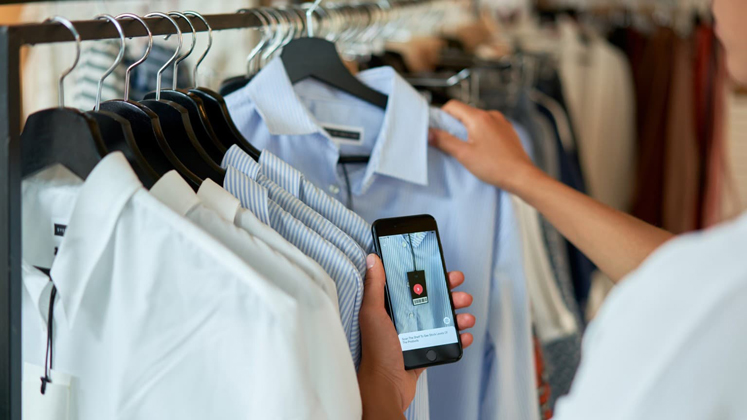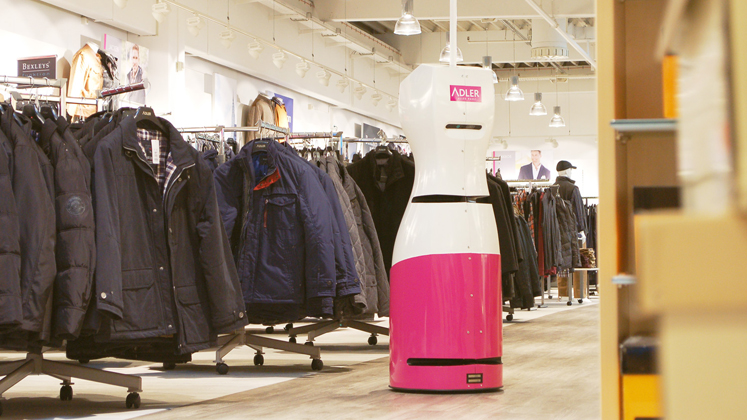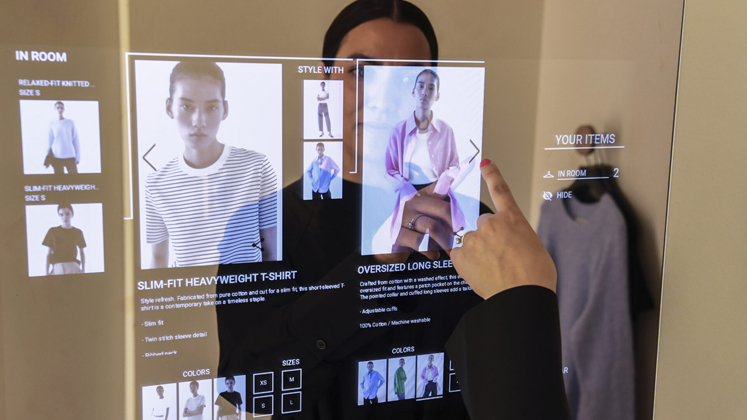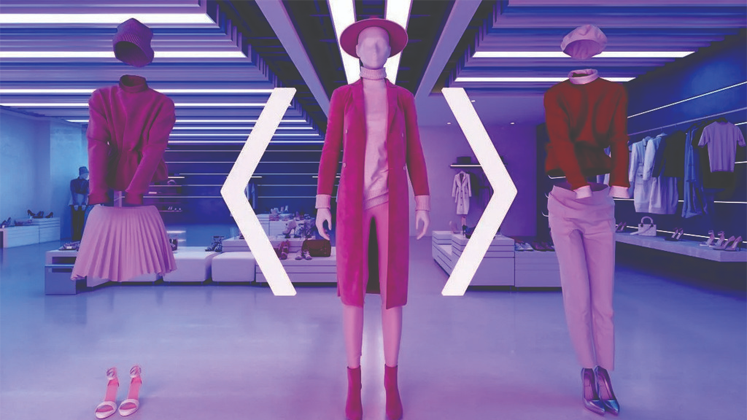The effects of AI and technology on the retail industry are far-reaching, and the industry is embracing the trend – a trend that will remain – by becoming more and more technologically advanced in order to meet growing consumer demand for more convenient and attractive products. and easy ways to shop.
Physical stores are adopting and exploring innovative technologies to improve areas such as checkout and payment solutions, data analytics, and customer-centric marketing.
In his report Seeing is believingPwC says virtual reality (VR) and augmented reality (AR) have the potential to deliver a £1.4 trillion boost to the global economy by 2030.
The report goes on to highlight that the use of virtual reality and augmented reality in the retail and consumer sector will bring a £184.2 billion boost to global GDP by 2030. Retailers will be able to create new customer experiences, from virtual fitting rooms for fashion stores, to AR apps that let people test out how furniture looks in their homes before buying it.
Jeremy Dalton, Virtual Reality and Augmented Reality Manager, PwC United Kingdom says: “Businesses, the economy and society are currently at a crucial stage in the adoption of virtual reality and augmented reality. Technology and hardware are finally coming of age, and Virtual Reality and Augmented Reality have the potential to give a significant boost to the global economy and make organizations work better, processes run faster and more efficiently, educate people more effectively and create amazing user experiences. ”
Virtual reality and augmented reality have the potential to add US$1.5 trillion to the global economy by 2030 – PwC Seeing is Believing report
The technologies will also help retailers better understand shopper behavior through advanced consumer research. In this article, we highlight five key technology-driven solutions that are expected to become important in improving the fashion retail industry in the future.
smart labels

The labels of the future show and describe much more than the price and size of a garment. New smart labels are becoming more and more popular in the fashion and retail industry to help customers and retailers.
New era RFID tags allow brands to count inventory accurately and quickly, while facilitating a wide range of other services, such as instant in-store verification of product availability, discreet security systems and also smart fitting rooms.
These tags carry an RFID chip that essentially acts as a license plate for an item.
For customers, smart tags allow instant access to a wealth of information about a particular brand or product. And we are seeing a growing trend of consumers around the world already asking for QR codes or NFC tags. This trend has been largely accelerated by the pandemic, with the fashion industry moving towards adopting greater sustainability and traceability processes.
New era RFID tags allow brands to count inventory accurately and quickly, while facilitating a wide range of other services, such as instant in-store verification of product availability, discreet security systems and also smart fitting rooms.
NFC tags (which require tapping a phone to access information) and QR codes (which need to be scanned by a camera) can both be used to display a garment’s history, sustainability, providing information and facilitating circular services such as authentication, repair and resale. However, while NFC tags are small chips made from metal, QR codes simply feature a small imprint, often created using ink, so various companies see QR codes as a more durable option. when it comes to choosing smart tags for products.
In-store robots

The life of the Jetsons isn’t too far off, especially now that companies are trying their hand and open to exploring technologies involving the use of automated robots that can take on the costly and time-consuming work of counting inventory and give store staff more time for other tasks, such as dealing with customers.
One company working on such a robot is MetraLabs. The robotics solution maker has built a robot called Torywhich scans inventory using RFID (radio frequency identification) technology, which can be used in stores after hours, or even when customers are in store during the day.
The robot recognizes and captures 99% of all RFID tagged items, is 10 times faster than manual inventory and can run for up to 18 hours before needing a recharge.
Additionally, the robot can be equipped with a multi-modal user interface with voice and touch input, allowing customers to ask where to find a particular product or department. Tory is currently used in hundreds of stores across Europe and Australia, including Decathlon, Kmart Australia and Adler Modemarkte.
Smart mirrors

Smart mirrors are becoming increasingly popular in fashion retail, streamlining the buying process and merging the physical with the digital to allow consumers to compare, browse and style products more easily without having to several round trips between the store and the locker room. .
Changing rooms at digital signage company Scala are equipped with sensors that use RFID technology to recognize the products a customer is holding. The product is then displayed on a screen on the mirror allowing shoppers to view similar products, browse other looks from the store and check availability, all without having to leave the dressing room.
Shoppers can also take a short video of themselves wearing the product while performing a 360° turn so they can see how the garment looks on them from all angles and in motion.
Amazon Fashion and H&M Group are just one of many fashion companies that have introduced the concept of smart mirrors to their stores. H&M announced last month that it would start testing smart mirrors in its Cos stores in the United States.
Footfall/People Flow Trackers
Monitoring shopper behavior inside stores is extremely valuable for retailers. Knowing how customers move through the store, for what items and how long they stay can help fashion companies maximize sales.
A tech company to do just that is a Swiss tech company xovis, which develops, produces and distributes 3D sensors and software. The Bernese company’s sensors can be mounted to measure important KPIs, such as footfall, time spent in the area, customer journey and conversions per customer and/or square meter.
Using tracking technology, fashion retailers can more efficiently reorder their products to place the most popular items in high-traffic areas and ensure customers see more of what they want to see and less of what they want. that they don’t see.
By knowing, for example, what order of items shoppers like to browse in stores, retailers can rearrange their products, or the store layout itself, to ensure the best chance of purchases. xovis said united fashion that with a German partner, it was able to increase the sales conversion rate by up to 15% thanks to its technology.
Immersive shopping experience

By leveraging the universe of options and opportunities presented by the Metaverse, retail stores can provide customers with better engagement and a 3D visual experience by effectively closing the “immersive experience” gap.
Currently, popular online shopping platforms are unable to provide such an experience, leading customers to opt for offline product trials followed by online purchase (showrooming) or a deposit.
The Metaverse offers customers the opportunity to try out various products from the comfort of their own home while avoiding the effort that shopping in physical stores might entail. Many brands that have embraced the metaverse concept have presented their buyers with a virtual shopping experience.
The Metaverse allows shoppers to venture to all floors of the store, try on items, and purchase them, all without leaving their homes.
This allows shoppers to venture to all floors of the store, try on items and purchase them, all without leaving their homes. And it is already happening.
Retail clothing brands have launched their first virtual store that allows customers to shop in a 3D environment, while leading cosmetics brand retailers have also embraced augmented reality and virtual reality via a makeup application that uses facial recognition to allow customers to try products remotely.
Companies must take initiatives to capitalize on virtual reality and augmented reality.
From creating new customer experiences to accelerating product development and improving workplace safety, many existing and emerging uses of these technologies promise to drive growth from the current contribution of GDP of £46.4 billion.
We conclude with Jeremy Dalton’s excerpt from PwC’s press release: “Organizations that may have struggled to see how virtual reality and augmented reality fit into their business need only consider the myriad existing and emerging examples of research.Now is the time for them to think about how these technologies can improve their performance or they risk being left behind.
He added, “Organizations need to look beyond the software development stage and focus on designing solutions to solve a specific business problem. Virtual reality and augmented reality can be used to speed up processes, improve security, reduce costs or open up new revenue streams.

